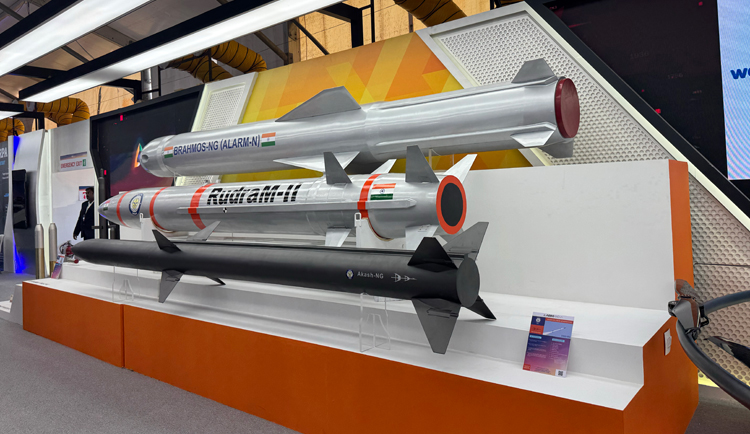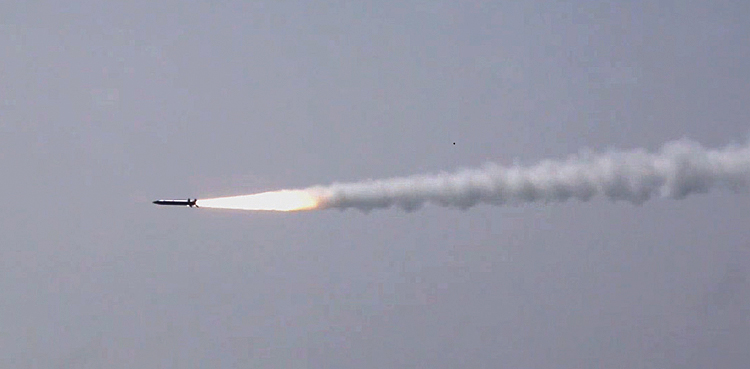INDIAN ARMED FORCES CHIEFS ON OUR RELENTLESS AND FOCUSED PUBLISHING EFFORTS

The insightful articles, inspiring narrations and analytical perspectives presented by the Editorial Team, establish an alluring connect with the reader. My compliments and best wishes to SP Guide Publications.

"Over the past 60 years, the growth of SP Guide Publications has mirrored the rising stature of Indian Navy. Its well-researched and informative magazines on Defence and Aerospace sector have served to shape an educated opinion of our military personnel, policy makers and the public alike. I wish SP's Publication team continued success, fair winds and following seas in all future endeavour!"

Since, its inception in 1964, SP Guide Publications has consistently demonstrated commitment to high-quality journalism in the aerospace and defence sectors, earning a well-deserved reputation as Asia's largest media house in this domain. I wish SP Guide Publications continued success in its pursuit of excellence.
- Operation Sindoor: Resolute yet Restrained
- India’s Operation Sindoor Sends a Clear Message to Terror and the World – ‘ZERO TOLERANCE’
- Japan and India set forth a defence cooperation consultancy framework, talks on tank and jet engines
- Terrorist Attack in Pahalgam in Kashmir: Unfolding a long surgical war against PAK
- Lt General Pratik Sharma takes over Command of Indian Army's Northern Command
The Rudram Punch
The Rudram-II, Rudram-III, and Rudram-IV missile family represents a transformative capability that will significantly enhance India's air-to-surface strike options while providing crucial SEAD capabilities
 |
The Author is Former Director General of Information Systems and A Special Forces Veteran, Indian Army |

India is developing the indigenous Rudram series (Rudram-I, Rudram-II, Rudram-III and Rudram-IV) of supersonic/hypersonic weapons designed to neutralise enemy radar installations and conduct precision ground attacks. Rudram in Sanskrit means "Removal of Sorrows". According to media reports of June 8, 2025, the Defence Research and Development Organisation (DRDO) promises to revolutionise the country's air-to-surface strike capabilities through the Rudram missile development programme. Rudram-I is a supersonic anti-radiation missile (ARM) with a range of up to 200-km, designed to target enemy radars and communication systems. Successfully tested in 2020, it is integrated with the Sukhoi Su-30 MKI of the Indian Air Force (IAF) and is set for serial production.
The primary strategic purpose of the Rudram missiles centres on Suppression of Enemy Air Defences (SEAD) operations, with each variant incorporating sophisticated anti-radiation capabilities designed to neutralise enemy surveillance and communication systems
The primary strategic purpose of the Rudram missiles centres on Suppression of Enemy Air Defences (SEAD) operations, with each variant incorporating sophisticated anti-radiation capabilities designed to neutralise enemy surveillance and communication systems; providing the Indian Armed Forces with stand-off strike capabilities that can penetrate heavily defended airspace while maintaining tactical flexibility.
Each variant of the Rudram series addresses specific operational requirements while building upon proven technologies. Rudram-II is a hypersonic missile with a rage of 300-km, featuring both anti-radiation and ground attack variants; successfully flight tested in May 2024, validating its propulsion, control and guidance system, positioning the missile for potential induction into the IAF as a replacement for the Kh-31 missiles currently in service. The missile's imaging infrared (IIR) seeker enhances its precision against diverse targets. Rudram-II, while primarily supersonic, incorporates advanced propulsion technologies that enable high-speed engagement of time-sensitive targets.
Rudram-II is a hypersonic missile with a rage of 300-km, featuring both anti-radiation and ground attack variants; successfully flight tested in May 2024, for potential induction into the IAF
Rudram-II features an advanced passive homing head capable of detecting, classifying, and engaging radio frequency sources across a wide spectrum of frequencies as programmed. This system can identify and track radar emissions from distances exceeding 100-km, providing substantial stand-off capability that keeps launching aircraft safely beyond the engagement envelope of most surface-to-air missile systems. The missile's Lock-On-Before/After-Launch capability offers tactical flexibility, allowing pilots to engage multiple targets in rapid succession or adjust targeting parameters based on evolving battlefield conditions.

Rudram-III is a two-stage hypersonic missile with a range of 550-km, designed for deep penetration strikes. It features a booster stage and a deep pulse motor with 16 control surfaces for high manoeuvrability. Presently under development, it is expected to exceed the air-launched BrahMos in speed and payload. For Rudram-III, the DRDO contracted 'Ameya Precision Engineers' to supply Empty PCB Warhead Assemblies. Captive flight trials for the Rudram-III are scheduled in 2025, indicating a critical phase where the missile's performance, reliability, and platform integration will be thoroughly evaluated. Rudram-III represents India's hypersonic weapon capabilities, achieving terminal speeds of Mach 5 or greater through its sophisticated dual-pulsed solid rocket motor configuration. The hypersonic design of Rudram-III enables the missile to perform complex flight profiles that can defeat advanced air defence systems through unpredictable approach vectors.
Rudram-III represents India's hypersonic weapon capabilities, achieving terminal speeds of Mach 5 or greater through its sophisticated dual-pulsed solid rocket motor configuration
Rudram-IV, according to DRDO chief Samir V. Kamat, will be a long-Range Stand-Off Weapon (LRSOW) with a range surpassing Rudram-III's 550-km. Rudram-IV is expected to be lighter, enabling greater operational flexibility and integration with IAF's Sukhoi Su-30 MKI, Mirage 2000 and possibly even with Rafale jets. Its hypersonic speed exceeding Mach 5 will make it nearly impossible to intercept by advanced air defence systems. Initial reports of Rudram-IV, the acceptance of necessity (AoN) was approved by the Defence Acquisition Council (DAC) in 2023, suggest that the LRSOW will be a subsonic cruise missile with a range of 1,000-1,500 km. Key features is Rudram-IV are likely to be: Hypersonic Speed – achieving speed above Mach 5 likely in terminal phase to evade enemy radar and interceptors; Precision Guidance – utilising INS-GPS navigation and possibly advanced seekers like IIR or passive homing heads for pinpoint accuracy against command centres, radar installations and fortified bunkers; Lightweight Design – lighter than Rudram-III (600-700 kg), allowing for greater payload flexibility and integration with wide range of aircraft; Quasi Ballistic Trajectory – enabling low-altitude manoeuvrable flight paths to bypass air defence system arcs – similar to the Russian Kinzhal missiles.
Beyond their primary anti-radiation mission, the Rudram missile family incorporates sophisticated ground attack capabilities that significantly expand their tactical utility in modern warfare scenarios. The Rudram-III exemplifies this multi-role approach through its dual-variant configuration, offering both anti-radiation and ground-attack versions equipped with different warhead and seeker combinations. The ground-attack variant features a 200-kg Penetration-Cum-Blast (PCB) warhead specifically designed to neutralise heavily fortified military installations, including bunkers, command centres, communication facilities, and other hardened infrastructure. This substantial warhead capacity, combined with the missile's hypersonic speed and precision guidance, creates a weapon system capable of engaging the most challenging ground targets. DRDO Chief Samir Kamat says Rudram-IV's hypersonic capabilities will make it a force multiplier for the IAF, enhancing its ability to conduct deep strikes while remaining within Indian airspace, which is particularly significant for targeting enemy surface-to-air (SAM) systems and critical infrastructure along contested borders.
Rudram-IV, according to DRDO chief Samir V. Kamat, will be a long-Range Stand-Off Weapon (LRSOW) with a range surpassing Rudram-III's 550-km
The Rudram-II, Rudram-III, and Rudram-IV missile family represents a transformative capability that will significantly enhance India's air-to-surface strike options while providing crucial SEAD capabilities for modern warfare scenarios. The hypersonic speeds achieved by these missile systems, particularly above Mach 5, ensures that enemy air defence systems face unprecedented challenges in detecting, tracking, and intercepting them. The development of Rudram-IV comes amid heightened regional tensions, particularly with China and Pakistan and in the wake of Operation 'Sindoor'. Rudram missiles are designed to counter the growing network of air defence systems and fortifications along the borders with these two countries. With its hypersonic speed and extended range, Rudram-IV is a counter to systems like China's HQ-9 and Pakistan's HQ-16 SAM systems.





